 Photo courtesy of
Photo courtesy of
 Photo courtesy of
Photo courtesy of
MEET THE EDITORS
EdwinEdwin Feng is a freshman at LASA who has a passion for basketball and loves to meet new people. He plans to major in computer science and find a good job in the booming coding industry. Edwin wants to write an eye-catching story about Chinese restaurants in Austin, as he has always had an undeniable love for Chinese food. He finds joy in doing math and enjoys playing video games.
BishopBishop Britt is a freshman at LASA who enjoys spending his time playing soccer and lounging. After he graduates, he wants to see the world and learn more about the environment and wildlife. In our magazine, he will be writing about Italian foods around Austin. He claims to be Italian and loves making food in the kitchen. He found his love for food from his grandmother who made homemade Italian recipes.


Zeke
Zeke Simeloff is a freshman at LASA who has big dreams to go to Berkeley, The University of California. He loves meeting new people and hanging out with his friends, has a dog, and enjoys playing Water Polo to challenge himself. He wants to write about the rise of TexMex, and how it came to be. Zeke’s passion for food came from his love for eating and connections to restaurant owners.

Sophia
Sophia Boren is a freshman at LASA who has a passion for art, and loves music. After LASA, they don’t quite know what they want to do, but they are very interested in new experiences. Sophia wants to write about food trucks exploring things like plant based meats and vegan food trucks. Sophia also has a wonderful cat named Ginger.

LETTER FROM THE EDITORS
Dear Readers,
We, the editors of Austin Appetites, are excited to show you our final work. Our freshman fall semester has been full of ups and downs, but working on this magazine has been one of the most memorable experiences we have had at LASA. Our creative minds have been put to the test throughout the semester, and we have had to learn so many different skills. Days were spent gathering interviews, researching topics, and designing pages. Learning more about the roots of restaurants in Austin has been a pleasure, and we cannot wait to show you what we have been doing this semester.
We hope that you enjoy our final work and come to love food just as much as we have!
A tasty dumpling covered in soy sauce. Find more at Bao’d Up, a local Chinese restaurant in Austin.

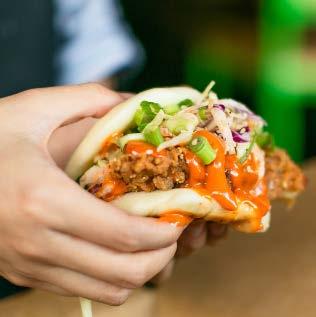
Tso Chinese Delivery’s orange chicken with broccoli, a common meal that can be ordered online.
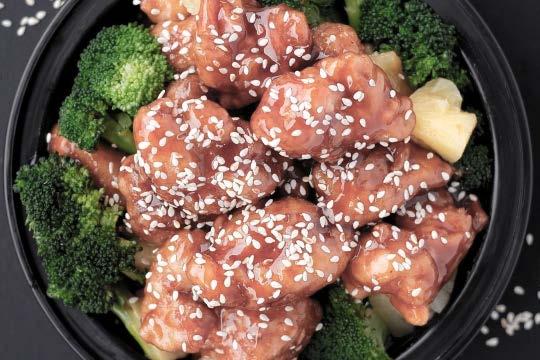
Step. Step. Step. You enter that local Chinese restaurant that you have been dying to go to. A sweet aroma fills the air, and you can already feel the rich culture brewing inside. That is the environment of a Chinese restaurant, which is defined as one of the most iconic cultures in America. Chinese Restaurants across a bustling environment such as Austin all have their own stories that have yet to be told. Chinese restaurants have had to adapt and create ideas throughout the years to survive. The disease wreaked havoc among all sorts of businesses, but the restaurant industry was hit the hardest.
COVID-19 was one of the worst diseases in modern-day history and due to false, ignorant, and inflammatory information, many point fingers at Chinese people for ‘bringing the disease’. Because of these negative connotations towards Asian restaurants, many loyal customers stopped going to their local Chinese restaurants. Alex Qiong, Co-Owner, and CEO of Bao’d Up, a locally owned Austin business that started in 2017, had to shut down several restaurants in order to survive the pandemic. “In order to keep the remaining staff, we closed a few Bao’d Up restaurants in order to keep the other few running,” Qiong said, “At one point we only had two locations open. That was tough.” After that bumpy road from Covid, things turned up for the Bao’d Up business. The
company has grown significantly and its ratings have started going up. Business owners like Alex have had to make impactful decisions every day, and that decision to close two restaurants has allowed his business to boom this year.
Every business in the restaurant industry evolved in its own unique ways, which is something Steve Tucek, Vice President of Operations at Mama Fu’s, had to partake in. His business was able to endure the pandemic using his creative thinking. “What we ended up doing is kind of rebuilding our model and as it changed, we actually morphed with it. So, that way we were able to stay open and still stay competitive,”
Steve Tucek stated.
Steve’s business had to completely shift to a ToGo model in order to
A delicious packaged meal from Tso Chinese Delivery, with chicken and broccoli.

A tasty Bao in front of a local Bao’d Up store. Bao’d Up also sells noodles and boba teas!

“
“
Austin is home to me and Austin is home to Tso Chinese delivery and our customers are the Austin community. And so it was important for us to reach out, engage with our community, and let them know that we’re here to support them.
Photo courtesy to Tso Chinese Delivery Photo courtesy to Bao’d Up - Min Choe, Owner of Tso Chinese Deliverystay in business. A To-Go model is where all the food is packaged up, and the customer eats at their own home instead of at the restaurant. Customers call the restaurant, make an order, and then pick it up at the restaurant’s front doors. Many restaurants had to institute the same model, as customers would rarely enter their doors.
Jim Li, the owner of House of Three Gorges, has one of the most impressive restaurants in Austin. Featured in many local magazines, his business has become reputable across the city. Unfortunately, just three weeks after his restaurant’s first opening, COVID struck,
leaving his business in shambles. He was forced to close the dining room and serve a To-Go model like Tucek. “We had to make some changes to our menu because certain Chinese dishes are not suited for take-out orders. We made changes to ensure we maintain high-quality standards,” Li said.
Min Choe, the owner of Tso Chinese Delivery, owns a restaurant that establishes the creativity of the human mind. Min Choe is known for giving back to the community, with his Tso Giving organization and his strict No Tip policy. Min Choe stated, “Chinese
“
A delicious meal ordered from Tso Chinese Delivery online. Each container is filled with a serving that is cheap and tasty!

“
When Omnicron hit the labor shortage was very tough... In order to keep the remaining staff we closed a few in order to keep the other few running. At one point we only had two locations open. That was tough.
- Alex “Qiong” Wu, Co-founder of Bao’d Up Photo Courtesy to Tso Chinese Deliveryfood has a little bit of a negative history, a reputation that’s a little bit on the down, on the negative side. I would challenge any new Chinese restaurant entrepreneurs to change that mindset.” Unfortunately, during the pandemic, this ideal was further expanded upon. Many Chinese restaurants, not just in Austin, were forced to close their doors because of the customer drop. However, what set Choe’s business apart from the rest was how his restaurant was modeled. Tso Chinese Delivery began as an online delivery service, with closed-door kitchens. This made the swift transition into the pandemic relatively easy for a company like Choe’s. Choe stated, “In many ways, we were pretty well positioned to adapt to the government mandates
and the shutdowns and such that Coronavirus Pandemic brought on.”
Although Choe’s restaurant was ready to fight the pandemic, he still had to make minor changes such as transitioning to contactless delivery. With his business surviving, Choe did something unexpected. He knew his business was doing great, but what about the rest of the industry? Thousands of people were fired, laid off, and had no food on the table. Choe started the Tso Giving initiative, which provided free hot meals to
people in the service industry. “To date, I think we’ve now come, it’s over $250,000 worth of food we’ve donated to the community, and we’re still donating through our Tso Giving initiative,” Choe said.
This year, you can find these businesses all over Austin. Bao’d Up now serves in the Austin FC stadium, Tso Chinese Delivery boasts one of the greatest reputations in Austin, and Mama Fu’s continues to expand their restaurant empire each day.

COVID-19 has beaten and battered
all these restaurants, but they have all recovered in their own unique ways. Their stories go to show how perseverance through the lows can allow for success in the highs.
Austin is Unbelieva-bao!
by Edwin FengPersonal recommendations for Asian Foods and where to find them!
Dim Sum
A tasty traditional Chinese meal originating from the Song Dynasty. This meal contains several small dishes that never disappoints!
Sushi
Sushi is a Japaense dish containing speically prepared rice served with raw fish, vegatables, or eggs. This dish is extremely popular and super easy to eat. Just grab and go ham!

Baozi
Baozi or bao is a filled bun that originates from China. They have many different fillings to fit your taste, sealing its spot as one of the top Asian eats.

Ramen
Ramen is Japanese noodle soup dish originally imported from China. With so many toppings and broths to choose from, it is sure to be your next big craving.
L’Italy The Best
BySuper creamy pasta, yummy garlic bread, a pizza swamped in cheese with a mountain of meat on top. This is what you’d expect going out to eat Italian food in Austin or anywhere in the United States, but going out to eat in Italy you’d find that these same exact foods have little in common.
There is a lot of culture around food in the pasta kingdom. “In Italy, they are very proud of their culture, and because of that, they have not experimented much with their cuisine for many decades.” says Silvia Arévalo, owner of Mangia La Pasta. Italian meals are eaten in light portions and spread evenly to create a healthy plate. An example of this is Pizza. Pizza is only occasionally made with beef or chicken, it’s meant to be eaten on the go. My grandmother (my nonna) explains her experiences:
A traditional pasta strand wrapped around a metal fork.

“As a kid in Italy, the food never had so much cheese or toppings, it was so much simpler.” Pasta is also very different as it’s rarely made with cream and is served in much smaller portions to not fill you up before the other food arrives.
Italian food had these big changes when Italians started heavily immigrating to the states in the late
Photo Courtesy of UnsplashSome delicious Italian pizza right out of the oven, ready to be devoured.
cheese pizzas with your choice of toppings. This style of pizza came to be known as New York style pizza, and it was a hit!
“ “
As a kid in italy the food never had so much cheese or toppings, it was so much simpler.
-Norma Britt, my nonna
Popular Italian restaurants have followed in Lombardis footsteps and made NY style their staple. Austin Italian restaurants are an example of this: Chief operations officer of Juliet Italian kitchen, Bryan Cromwell, shares that Juliet revolves around “New York Italian’’ like many Austin restaurants, but also adds in some “authentic Italian flair” for those looking for it. Juliet strives to make the best possible Italian food they can using food that is “baked
19th century, and with them, they brought their recipes and food. The recipes started to change when ingredients needed for the recipes were much more scarce, or new to America due to the transatlantic trade, and therefore were not of high quality. With ingredients, these now Italian-Americans started to experiment, add twists, and modify their recipes to find a new version of the beloved cuisine. Meat was plentiful so it was added while veggies were taken away, a light and airy food that was simply a part of a meal became a heavy, filling, whole meal and people absolutely loved it.
This idea of having a pizza as a whole meal opened the door for pizza-only restaurants in America. This is when the first pizza shop was opened in NYC in 1905 by Gennaro Lombardi. Its name was Lombardis, and it served large
 Photo Courtesy of Unsplash
Photo Courtesy of Unsplash
 Photo courtesy of Unsplash
Photo courtesy of Unsplash
and made daily [with] Top end quality ingredients”.
Not only is running a restaurant business very difficult, Bryan says, “There is very little in the restaurant business that is easy”, but Italian restaurants are especially difficult to keep afloat because of the high demand and skill needed.
Juliet Italian kitchen states that the way they keep up is by “simply [trying] to do our best, have excellent food, great service, and a welcoming atmosphere.”
All a restaurant can do is their best, you can’t pay to have people eat your food
restaurant to begin their business in a smaller capacity,” Which skips over a lot of complications and makes it much easier to start a restaurant. Mangia La Pasta tries its best to keep true to
creation of our own.” The Arévalo sisters told me that to keep up with competitors in Austin, they try to “focus on making sure that our ingredients, our recipes, and our finished dishes are always made with the best ingredients fresh every day.”
Italian food has changed much from one country to the next, from small details like a sprinkle of basil to large details such as lumps of meat. Every Italian restaurant you go to will have its own creations and recipes and will all surprise you. I encourage you to give one of these amazing restaurants a try, I promise you will love them.
Grazie per aver letto.
and make a profit, you have to have food that people want to try and come back to eat again.
A new type of restaurant called Ghost kitchens have arisen due to the pandemic. These ghost restaurants take a spin on normal restaurants, and instead of having dine-in, they use DoorDash and Uber Eats to deliver their food. Silvia Arévalo explains that “[Ghost restaurants] are also a way for people who would normally not be able to afford the expensive investment of a full-service
Italian recipes, the “head chef’s two decades in Italian kitchens for the most part [our recipes] stay true to their roots.”
The restaurant also enjoys throwing in some of its own twists on recipes, as they have “brought some American aspects into [the] menu, for example, Mangia Pasta (type of pasta) is a
“
“
[We] focus on making sure that our ingredients, our recipes and our finished dishes are always made with the best ingredients fresh every day. -The Arevalo Sisters
Impastably Good


The best recipe for Italian-American creamy pasta.
By Bishop BrittIngredients
Simolina flour, (or all purpose) Water, Eggs, Salt, Olive oil,Parmesan, Heavy cream, Pepper, Thyme, and Basil.

A guide to making Italian grade pasta with an American twist to make the best comfort food: Creamy Alfredo Pasta.
Tools needed
Large bowl, Small whisk Medium pan, a Spatula Rolling pin, Large Pot Plastic wrap/ Kitchen Towel Measuring cups
Get a large bowl and a small whisk or fork. Add 2 cups of flour into the bowl, followed by 1 tsp of salt. Mix until salt is evenly distributed in the flour. Make sure that you dont add any wet ingredients yet as you dont want to mess up the recipe.
Make a bowl like structure in the middle of the mixture by pushing the flour and salt to the sides of the bowl. Now in the bowl you created you’ll add the wet ingredients 1/4 cup of Water, 2 Eggs, 2 Tbsp of Olive oil and get a whisk or a fork in preparation for the next step.

Mix the wet ingredients inside of the flour bowl you created in the last step. Once fully combined start slowly incorporating the flour and salt. You will need to start mixing with your hands as it turns to dough and toughens so go wash your hands!
Once all of the flour and wet ingerdients have been mixed together it should turn into a rough dough. Clear a space on your countertop and pour out the dough and start kneading it (rolling and pushing it to work the gluten). if the dough is too sticky then add a tablespoon of flour and if it doesnt stick to itself then add water.

After kneading for ~10 mins, the dough will come completely together and to know its ready make it into a ball (shown on right) and press a finger ever so softly into it. If the dough bounces back then its ready, if it doesnt bounce back then keep kneading. Now you’ll need a kitchen towel or plastic wrap to wrap the dough in to it from drying. After you wrap it up leave it out on a counter or warm place for 25 mins.
Now you’ll roll out the dough (cut it into 4ths to make it easier). This might be difficult, make sure you get it thin enough that you can see your hand through it when held to the light. Prepare the water by filling a large pot 1/4th up with water and add about 2 Tbsp of salt to the water. Heat the water and go back to the pasta.

Cut the pasta into thin noodles using a dull knife. They can be long, short, thick, thin, wide, however you like them. Heat up a pan to low-medium heat. Once heated add 1-1.5 cups of heavy cream to your pan, .5-1 cup of parmesan depending on how cheesy you like pasta, and then 1 tsp pepper, and a little bit of thyme if you want it. Keep mixing until creamy and incorporated. Keep the heat on low until the pasta is done.

Hang the pasta until all of it it cut, and then add to a large pot with boiling water and salt. Cook until there is a slight toughness in the middle (Al dente). Turn the heat off and pour the water into the sink. Add the pasta to a bowl with the sauce, mix it, and then add basil to top it

Cook until there is a slight toughness in the middle (Al dente). Turn the heat off and pour the water into the sink. Add the pasta to a bowl with the sauce, mix it, and then add basil to top it


Now you have finished your very own pasta. Congrats, now go enjoy your pasta with your family, and if you see me in the halls, be sure to thank me.


Mexcellent How Mexican food became Tex-Mex
 By Zeke Simeloff
Photo curtesy of UnSplash
By Zeke Simeloff
Photo curtesy of UnSplash
Austin has become a city full of flavors, but there’s one flavor that’s managed to stick out of the crowd more than the rest, Tex-Mex food. We all know how popular Tex-Mex food is today with restaurants like Torchy’s, Tacodeli, and Chuys but how did Tex-Mex food become so popular?
Mexican food started off way back in the 1500s with the Aztecs having crops like beans, squash, chilies, tomatoes, and corn. With these crops, the Aztecs would start to make foods such as Tamales. The meat side of the Aztec diet was mainly fish and bugs like grasshoppers. “When the Spaniards came, Mexico underwent the convulsions that occur when one people supplant another, mixing yet keeping distinct identities.”
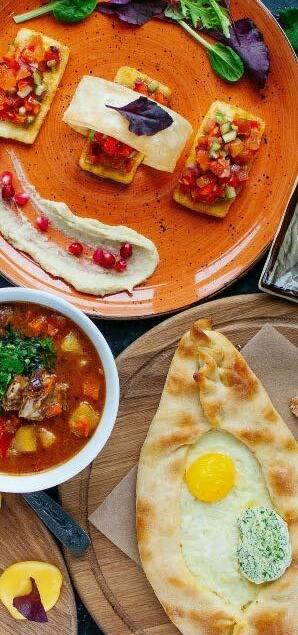
Gustavo Arellano said in his book Taco USA. The Spaniards would incorporate tamales, tortillas, and other ingredients into their daily life, and in return, they introduced bread, beef, pork, and chicken to the Aztecs. This can be traced today with staples in Tex-Mex like the Taco having flour tortillas from the Spaniards, but things like spices and beans from the Aztecs.
Over the next centuries, Spanish colonization started to take over more of the Americas. Their rule stretched from Chile all the way to Texas. In 1836, with the independence Texas gained from Mexico, they took a part of Mexican culture with them. In 1845, Texas joined the USA and from then on we see Mexican culture and food spreading throughout the United States.
In 1875, we see the term “Tex-Mex” coined. The term was used to describe the Texas Mexican railway and the people born in Texas of Mexican descent.The term
has since evolved and is now used to describe a specific type of food. One of the foods that was spread along the railway was chili. It’s debated by many historians where chili originated but most agree that it originated in border towns near the Río Grand Valley and overtime found its way to more northern places like San Antonio and Austin.
This Chili became really popular in these northern cities but nothing
compared to it’s popularity in San Antonio. A group of women in San Antonio, called the “Chili Queens” started selling Chili out of stands. Their Chili dish grew so popular that it became a tourist attraction.
As Jeffrey Pilcher describes it in his lecture Planet Taco: The Globalization of Mexican Cuisine: “everyone who was on the railroad to San Antonio had two stops, the Alamo and the Chili Queens.”
From 1893 to now, more Mexican restaurants have started to sprout. ne of them was a restaurant called “The Original Mexican Restaurant.” Otis Farnsworth, the owner of “The Original Mexican Restaurant”, created the idea of a combo plate. He called it the regular, a delicious meal with beans, rice, and an entree.
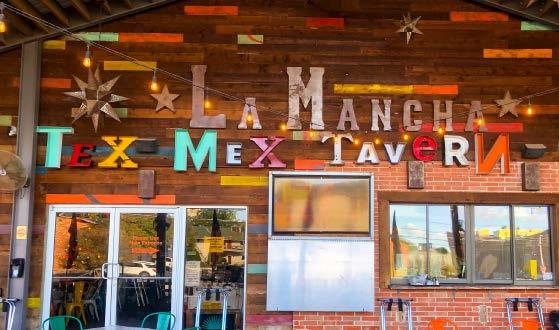
Eventually,
more Mexican restaurants copied Otis’s original idea, and many consider the regular to be the first staple of Tex-Mex food.
Eventually, between the 1950 and 1970s, more food from the Río Grand Valley like Fajitas started to gain fame at Tex-Mex restaurants. This resulted in growing comfort with the Idea of Tex-Mex. This brings us to the modern day Tex-Mex classics and inventions like Nachos. This Modern Tex-Mex staple came from a group of housewives and have now spread to almost every Mexican restaurant and even some American ones. It’s these new inventions and the food from the Río Grand Valley that makes TexMex so popular.
John Korioth, is the owner of EastSide tavern, Hangar lounge, Downtown Driftwood
This is a picture of La Mancha a Tex-Mex restruant that John Korioth owns Photo courtesy of Zeke Simeloffclub, La Mancha Tex-Mex tavern and founder of the non-profit Livestrong. John first started working in the restaurant industry when one of his friends asked “ do you want to bartend?’’ And he said, “Yeah, until I figure out what I want to do.” Korioth said “And I started bartending, and I enjoyed it. Eventually, I became a manager. And then I got hired away to another place, and another place.”
Eventually he decided that he wanted to open up his own bar. He went in with the idea that this bar was going to be really successful just like the other bars he had worked at. Unfortunately, it wasn’t popular, and “[he] had to really, really work to make it profitable and make it busy. And so, as I say to most people, I learned more in that business than I did it at two other bars that were very popular.”
Cole Kojak, a past manager at Chuy’s explained that the owners of Chuy’s “Mike Young and John Zap had already failed several times prior to opening Chuy’s and they make a big point out of saying that out loud to everyone.”

Kojak said, “The whole reason that they brought up their prior failures was to show that you have to get out there and try some things.”
When John Korioth was opening up La Mancha he decided that he would go into the business with a partner. One factor that John had to learn was how to work with a partner. “We had this thing where we connected. In order to make the business successful, communication was the key element in learning and making sure communications are clear.”
Another element that makes a business successful is a healthy work-life balance. Cole first struggled with this at some of his other jobs, overworking himself and becoming burnt out. “I realized I was working usually six days a week, sometimes seven days a week, and I was working about 70 or 75
hours a week.”
John shared a different experience about being healthy. “I was the big fat kid. I got made fun of. I got bullied.” Kojak said, but his experience of when he was younger made him realize that “a man spends a lot of time making money, and then man has to take that money to spend on trying to become healthy. So, it made me think, well, why am I spending all this time trying to make money and then trying to figure out how to get better?”
John says that health always comes first and that includes the health of the business. “We have to ask what’s best for the business, even if it means sacrificing a little bit, then we sacrifice because we know what’s best for the business.”
“
“
You cannot go straight to immediate success.
-Cole Kojak, Manager at Chuy’sThis is a picture of Chuys the resturant Cole Kojak managed. Photo courtesy of Pixels
THE Torchys Taco BEST
About this survey in this survey over 120 people were surveyed to get there opion on what the best Torchys taco was. The highest result was the breakfast taco having arround 20% of the vote. An intresting statistic that was found in this survey is that people prefered the chicken fajita to the beef.
What is Torchys?
Torchys is a popular Tex-Mex resturant that started in Texas. Torchys has now exapeded to over 100 locations across Texas, Oklahoma, Colorado, Arkansas, Louisiana, Missouri, Kansas, Indiana, North Carolina, Tennessee and Virginia.

How it all started.
Torchys founder, Mike Rypka, first started as a chef and worked at multiple restruants, but eventully he decided that he needed to start a resturant of his own. He then took out a bunch of loans and managed to buy his own food truck.
Thank you to https://torchystacos.com/ for providing valuble information for this ASF
Thank you to Autin After Hours and the interview of Mike Rypka done by Taylor Ellison for providing vauble information for this ASF. https://www.youtube.com/watch?v=UfElayxyZss
Food Truck Trends that are Kale-ing it
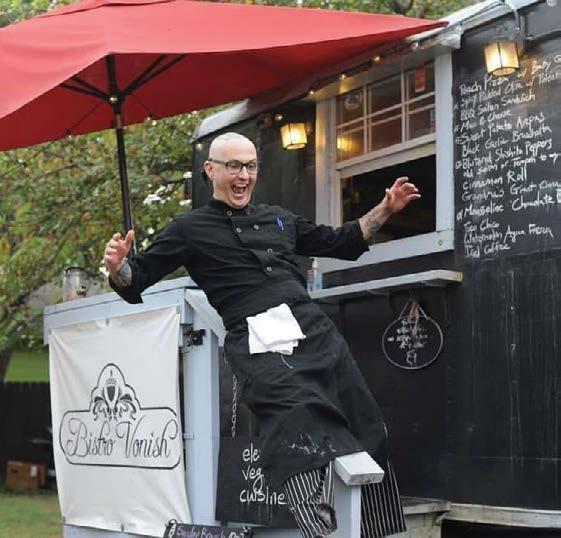 By Sophia Boren
By Sophia Boren
treet food’s popularity has exploded over the past five to seven years, and there are no signs that it will decline anytime soon. Why are people in the U.S. suddenly starting to eat at food trucks? Although the food is undoubtedly cheap and produced quickly, the appeal of mobile meals goes beyond those two factors. They provide specialty foods, vegan cuisine, and other ethnic cuisines that are fresh and authentic.
Vegan
As street food is expanding, so is veganism. So, what does it mean to be vegan? Being vegan is a lot like being vegetarian, no meat, seafood, or poultry of any kind, but in addition to that, vegans also don’t eat or use any food or products derived from animals, such as dairy products, eggs, and honey. But, why veganism? People choose to follow a vegan lifestyle for health, environmental, and/or ethical reasons. For example, some vegans feel that one promotes the meat industry by consuming eggs and dairy products. Many vegans choose this lifestyle to promote a more humane and caring world, they know

they are not perfect, but believe they have a responsibility to try to do their best, while not being judgmental of others.
“Faux Meat”
According to Changing America the number of Americans who identify as Vegan has grown over 500% since 1994. In addition, people are cutting back on their meat consumption in general, and the vegan meat substitute market is expected to increase by 25%. As more vendors meet the expanding demand, the vegan trend spreads to the street food sector. New vegan food trucks and stands appear and start serving veganized American food such as pizza, tacos, and burgers, that meat lovers can’t resist. “I think we are making progress. We have come a long way. We have fake meat, and it’s amazing. I feel closer and closer to the real deal without causing
any harm to animals” says Sergio, the owner of VegMex Nissi, a vegan business located in North Austin, “We want to make vegan food accessible to everyone. Let’s say if you want to become vegan, but then you find you don’t like tofu tacos and stuff like that, then we have the fake meat for you. It’s different. It’s like it’s real meat… And we want to make that available to everyone.” Sergio started his business after he turned vegan, and started vegan-izing his recipes to fit the lifestyle.
“At some point, you do want to go out to eat, but we couldn’t find anything that was vegan. For example, I wanted to eat authentic Mexican food… There are some good vegan tacos out there, but not like the way I used to make them at home. So, what if we use this service and provide these tacos to our family or to our community? So, then we decided to do Nissi in 2018.”
Food Trucks
Food trucks serving vegetarian and vegan food may be found all throughout the United States. They’re growing more and more well-liked as a result of their adaptability and accessibility. In Texas, there aren’t as many vegans as there are meat eaters, therefore prospective restaurant owners may be
hesitant to create a full-fledged all-vegan restaurant. However, food trucks are the ideal answer because they are cheaper for both restaurant owners and patrons. “Money was definitely the hardest part about starting this business”

Says Craig Vonis, owner of vegan business Bistro Vonish, “I had said that I want to open a restaurant and then say, Okay, well, how do you do that? Well, you need money and a following and investors and all those things. Like, okay, well, I don’t have any of that. So maybe start doing little pop ups and separate clubs and
like, sell Pilates at different events. ... I started the food truck to get enough money for my dream restaurant, but ended up loving the truck”.

Since food trucks are mobile by nature, you can find them at parks, pubs, farmers markets, concerts, and other special events. These are all open areas that are used by people of all dietary and lifestyle preferences. The availability of veg-friendly food for non-vegans is increased by the presence of vegan food trucks in these locations. And it might even show a lot of people that good, affordable vegan meals are possible! Additionally, many vegan food trucks visit places like “food deserts,” which have very little access to fresh, wholesome meals. For individuals who would not often have access to vegan cuisine, the food trucks that are selling their wares in these neighborhoods
can assist boost accessibility.
Contrary to a regular restaurant, individuals may come upon a food truck accidentally rather than on intent. The future of promoting the vegan and vegetarian diet is food trucks because of this. A vegetarian food truck might be at a concert, even though a meat eater might never choose to eat dinner at a sit-down vegan café! If we have food trucks in our towns, we should continue to support them since they work hard to advertise their food to all types of people. Try to find a vegan or vegetarian food truck while you are traveling if there aren’t any around where you live!
“Food trucks give creative entrepreneurs the ability to cook with freedom and make what they love, meaning that they can create highly specialized meals without having the high overhead costs of running a restaurant.”
- Homaro Cantu


AUSTIN
Sebastian Driussi. You either love him or you LOVE him. Driussi came to Austin FC last year, and had an immidiate impact. Scoring 25 goals and coming close to claiming the golden boot, he has already garnered a lot of fan attention. Driussi goes by many names. Legend, “That Guy”, “Scorer of more goals than your 6 year old kid in that YMCA league”, El Crack, and Him. Simply Him. He is deadly. He can curl the ball into the goal from wherever he wants to and you cannot guard him. Horseshoe of sadness? No problemo. Outside the box? Easy. Penalty? GOALIE WHO? BROKEN LEG? Well, maybe not. Nonetheless, Driussi is a key player in the AUSTIN FC squad. He distributes the ball with fast paced speed, and hits the balls right where he wants it to go. You want the ball on your left foot through 3 defenders legs and over the keeper? He will serve it to you on a golden plate and add some extra pepper on top. Now, how does a place like Austin get an absolute unit such as El Crack? Well, we got lucky. Before Driussi joined the “Tree Nation”, he was playing in Russia, tearing up the league. After arriving at Austin, Driussi has not only significantly boosted the team in every way, he has also helped the team gain strong new players. Emiliano Rigoni has come to Austin as a result of Sebastian Driussi. Rigoni has since boosted the offence ever since his arrival. In conclusion, Driussi is the goat. Cristy Ronaldo who? I do not hear no siu. Leonil Messy? Nah, get that outta here! I got my man DRIUSSIII!
 Photo courtesy of goal.com
Sebastion Driussi making a speech to a large crowd of Austin FC fans.
Photo courtesy of goal.com
Sebastion Driussi making a speech to a large crowd of Austin FC fans.
AUSTIN FC
By Bishop BrittA tasty bao from Bao’d up. Bao’d Up is a locally owned Austin Chinese food restaurant. Find them at the Austic FC staidum and grab a sweet bite!
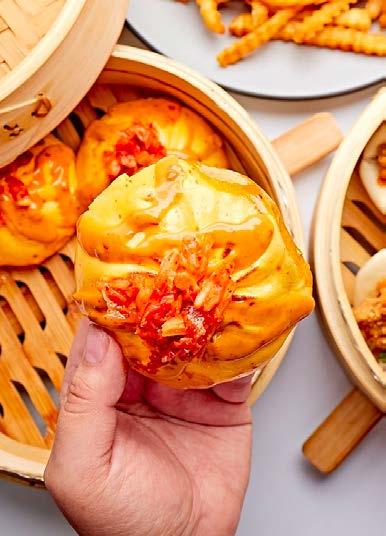 Photo courtesy of Bao’d Up
Photo courtesy of Bao’d Up
A u s t i n Appetites Fall 2022
 Photo courtesy of Unsplash
Photo courtesy of Unsplash
